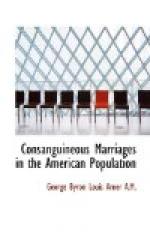----------- Stated |80,481| 3,911|73,639| 2,931| 4.9| 91.5| 3.6 Not stated | 8,806| 154| 1,891| 6,761| 1.7| 21.5| 76.8 | | | | | | | (a) relatives |21,660| 1,850|18,838| 972| 8.5| 87.0| 4.5 No (a) relatives |58,821| 2,061|54,801| 1,959| 3.5| 93.2| 3.3 | | | | | | | (a) or (b) relatives |25,851| 2,171|22,552| 1,128| 8.4| 87.2| 4.4 (a) and (b) relatives | 4,117| 412| 3,587| 118| 10.0| 87.1| 2.9 (a) but no (b) relatives |17,543| 1,438|15,251| 854| 8.2| 86.9| 4.2 (b) but no (a) relatives | 4,191| 321| 3,714| 156| 7.7| 88.6| 3.7 No (a) or (b) relatives |54,630| 1,740|51,087| 1,803| 3.2| 93.5| 3.3 ------------------------------------------------------------
----------- [A] Symbols for deaf relatives: (a) deaf brothers, sisters and ancestors; (b) deaf uncles, aunts, cousins, etc.
Table XXIX shows unmistakably that the connection between consanguinity and hereditary deafness is very close. Where there is the largest amount of deafness in the family the percentage of consanguinity is the highest. That is, of those who had both (a) and (b) relatives ten per cent were the offspring of cousins, while of those who had neither (a) nor (b) relatives only three per cent were the offspring of cousins. It is natural to assume that as a rule where the deaf have either (a) or (b) deaf relatives, deafness is hereditary, for the probability of two cases of deafness occurring in the same family, uninfluenced by heredity would be very small. It is likely also that a great many of the deaf who stated that they had no deaf relatives were mistaken, for few people are well enough informed in regard to their ancestry to answer this question definitely. Not one man in thousands can even name all of his great-grandparents, to say nothing of describing their physical or mental traits. Others may have understood the inquiry to refer only to living relatives and therefore have omitted almost all reference to their ancestors. These possible errors might easily explain all the excess of the percentage of consanguinity among those reported as having no deaf relatives over the probable percentage of consanguineous marriage in the general population. But this very probability that comparatively few deaf ancestors have been reported increases the probability that the greater part of the (a) relatives were brothers and sisters rather than ancestors. Now of the 26,221 deaf having deaf relatives, 17,345 have only (a) relatives, and if these are largely living brothers and sisters the relationship would “work both ways,” so that if there were two deaf children in a family, each would have an (a) deaf relative. In the Census of Ireland figures above quoted it will be remembered that among families which were the offspring of cousins the proportion having two or more deaf children was three times as great as among those who were not the offspring of consanguineous unions. If this follows in America, it largely accounts for the high percentage of the congenitally deaf who are the offspring of cousin marriages, and especially of those who have (a) deaf relatives.




